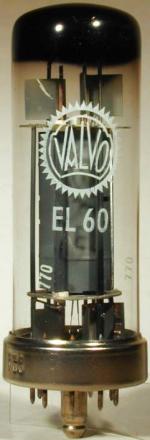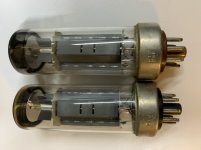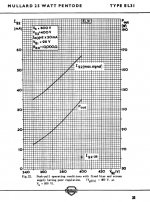If the '6' could be a 'S' than the code would fit an EL34.
'SY' indicates EL34 while the first '5' indicates that the tube is made by Toshiba, Japan.
'SY' indicates EL34 while the first '5' indicates that the tube is made by Toshiba, Japan.
That is the original Mullard EL34.
I used to have a few, I think made in NL initially then UK.
Nothing whatsoever to do with Toshiba.
They were discontinued from manufacture because they had the annoying tendency to blow up by uneven heating of the glass, and pop the glass off just above the metal ring.
(or so I was told officially from Mullard).
I suspect it's because the original EL34 was a (9 pin ) loctal valve, which has a similar construction, but made it monumentally unpopular, or near useless.

Some people of course are claiming EL60 are "rocking horse poo" and sound better than any other..
..usual twaddle of course, to jack up prices.
I used to have a few, I think made in NL initially then UK.
Nothing whatsoever to do with Toshiba.
They were discontinued from manufacture because they had the annoying tendency to blow up by uneven heating of the glass, and pop the glass off just above the metal ring.
(or so I was told officially from Mullard).
I suspect it's because the original EL34 was a (9 pin ) loctal valve, which has a similar construction, but made it monumentally unpopular, or near useless.

Some people of course are claiming EL60 are "rocking horse poo" and sound better than any other..
..usual twaddle of course, to jack up prices.
See page 4 for the place of production and page 9 for the type: http://www.r-type.org/pdfs/ref4110.pdf
I can't assess if the information on the codes in that link to the German site is correct or not but what is written in the intro made me smile. It was Philips (Bernard Tellegen) who invented the pentode and I would think that pentodes were already popular before 1937, especially in radios.
Yes, the EL60 was EL34's straight predecessor. Same specs and ratings, but with that unpopular 9pin Loktal base. Only few were made, hence they're valuable collectors' items nowadays.I suspect it's because the original EL34 was a (9 pin ) loctal valve, which has a similar construction, but made it monumentally unpopular, or near useless.
Some people of course are claiming EL60 are "rocking horse poo" and sound better than any other..
..usual twaddle of course, to jack up prices.
Anyway, I don't understand why they should sound better than EL34's. Fairytale, maybe?
Best regards!
The EF50 also had 'that unpopular 9pin Loktal base' (B9G). According to Radiomuseum.org hundreds of thousands of EF50's were made. So 'unpopular' seems to be a matter of definition.
They were discontinued from manufacture because they had the annoying tendency to blow up by uneven heating of the glass, and pop the glass off just above the metal ring.
(or so I was told officially from Mullard).
The real Mullard company is long out of business.
What exists now is a new company, which imports tubes from russia (I think) and brands them with a Mullard logo.
I think this is a fabricated story. So many other electron tubes had metal sockets (GZ34 for example or Siemens F2A or GE 6550) and all become very hot without any problems. The EL34 is no exception from the rule and its not known for becoming hotter than others. In the end, plastic was cheaper than metal and so they switched because it was a real mass market product and did cost them pennies in production. Now a real EL34 metal base sells for hundreds of euros. and nearly the same tube, just little different data sells for virtually nothing. Strange days...
Sorry but in this case you are wrong because the true story comes from inside MULLARD UK.I think this is a fabricated story.
So many other electron tubes had metal sockets (GZ34 for example or Siemens F2A or GE 6550) and all become very hot without any problems. The EL34 is no exception from the rule and its not known for becoming hotter than others
The EL34 being a cylindrical valve, with an unusually small glass, no pinch construction and the anode very close to the glass, was exceptionally prone to failure. (it still is), as well as constant fatal failures of the screen grid, because of secondary emission.
The EL34s in the works PA system used to fail constantly, because they insisted on using that rubbish, - daily failures no less.... (Until some enterprising guy in the works came one day and replaced them with a big pile of their competitors (KT88) from GEC)
hey presto,- no more failures, so an investigation was launched, (because they couldn't understand why it suddenly became 24/7....reliable).
The management came and stuck their noses in their, threw up their hands in horror and insisted on bunging all the EL34s back in, with the usual predictable results....constant & regular blow ups.
Go figure,-
many companies get rewarded for failing and Mullard was no exception.
The steel collar type EL34 was the early type, and used to POP the glass just above the collar, with a clean break, leaving what appeared like a small whisky glass over.
They moved to the bakelite base very quickly to get rid of this problem, while never resolving the melting G2, and quickly discouraging people from ever implementing the 800V anode voltage actually listed, designed to get a short but sweet 100W before the inevitable blow up came.
Try running a pair at 100W (easy + reliable on any GEC valve, even ancient KT8C or 807), and you will see instantly what I mean.
The screen starts to glow red quite fast, then white, then come the collapse with a firework display followed by disaster.
I have to assume this is why nobody ever tried to push its predecessor the EL31 claimed to make 120W at 800V....showing a real scary 22W screen dissipation figure at full power....
To boldly go where everyone knows will be disaster...eh?

The EL37/CV586 was basically the (EL31 no TC) EL34 with the big glass, (like the KT66) and are almost exactly identical inc the same 11mA/V but no top cap, so derated in use, and the old "pinch" type seal.
Cheap is not always cheerful, but hey that's what mass production is all about, isn't it, and does wonders for sales? 🙄
Attachments
Last edited:
Interesting tale!
You've mentioned your PAs before in the context of AB2. I have a few from the 40's myself, and would be interested to read about the design elements of those amps. You were pointing out the requirement for 24x7, and that is part of the interest I have in them.
Could you be tempted to kick off a thread on that theme?
You've mentioned your PAs before in the context of AB2. I have a few from the 40's myself, and would be interested to read about the design elements of those amps. You were pointing out the requirement for 24x7, and that is part of the interest I have in them.
Could you be tempted to kick off a thread on that theme?
It was used extensively in WW2 radar systems, which explains the high production figures.The EF50 also had 'that unpopular 9pin Loktal base' (B9G). According to Radiomuseum.org hundreds of thousands of EF50's were made. So 'unpopular' seems to be a matter of definition.
It was used extensively in WW2 radar systems, which explains the high production figures.
It was a surprise to me finding a bright red EF50 inside an old US military radio.
They made a heck of a lot of Dynaco Stereo 70 amps that used the EL34 and they were quite reliable. OTOH, they didn't sound their very best unless the output tubes were replaced every year or two.
For a number of years I've been repairing musical instrument amplifiers with tubes (mostly 6l6gc types like Fender and Marshalls using EL34's) and I seldom came across faulty EL34's (mostly Philips and Mullards). I still have a few Dynacords with EL34's with 700v on the plates and nearly 400v on the screens and even after 50 yrs they are still ok. Recently a had a few amps with JJ EL 34's and they had shorts. The same with their GZ 34 's. A friend came by with a 300B se
he had built himself and he had two GZ 34's failing instantly when he put the amp on. He thought he had made a mistake. I couldn't find anything wrong with it so I put in a used Philips GZ 34 and everything worked fine. I've built quite a few EL 34 amps for others (mostly using Philips and Telefunken tubes ) and never had complaints about failing tubes.
he had built himself and he had two GZ 34's failing instantly when he put the amp on. He thought he had made a mistake. I couldn't find anything wrong with it so I put in a used Philips GZ 34 and everything worked fine. I've built quite a few EL 34 amps for others (mostly using Philips and Telefunken tubes ) and never had complaints about failing tubes.
Yes, Most of the Dynaco Stereo 70 amplifiers came with genuine matched Mullard EL-34 output tubes.They made a heck of a lot of Dynaco Stereo 70 amps that used the EL34 and they were quite reliable. OTOH, they didn't sound their very best unless the output tubes were replaced every year or two.
They ran forever, never saw a failure. The DC grid voltage had to be around -32VDC for 50mA bias current.
The later PAS-3X preamplifiers came with four genuine Telefunken ECC-83 tubes.
In the '70's, I had a Selmer Treble & Bass 50 with 2 Pope (Philips) EL34. I rehearsed and gigged on a quasi daily basis for 10+ years without a single problem. Other guys I knew with Hiwatts and/or Marshalls occasionally had a few red plates because of incorrect bias, but nothing terminal.
Similar failure was with Tesla EL34, some of them has/had not too good quality of bakelite octal base, and if they run at 795V for 100W output from pair, it caused fails for short between A and F.

Was this only related to Tesla products? The vicintiy of plate at pin 3 and heater at pin 2 was an issue for any tube with this or simlar pinout (6L6 and similar or derivatives) when operated at higher plate voltages. Anyway, in my observation the arcing issue used to start at the tube holders instead of the bases, 'cause the isolation material is thinner at the holders than the bases. The bases were just infected. So, ceramic holders should be preferred in amplifiers with high supply voltages.
Best regards!
Best regards!
- Home
- Amplifiers
- Tubes / Valves
- Is this an EL34?

